Characteristics and Applicability Analysis of Nanomorphological Structures for Chemosensors: A Systematic Review
IF 3.7
3区 工程技术
Q2 CHEMISTRY, ANALYTICAL
引用次数: 0
Abstract
The necessity for complex functionality materials is increasing due to the emergence of high-tech technologies and the deepening needs of B-to-B companies in the industry. Study on advanced multifunctional materials is also increasing due to interest in fields such as the the Internet of Things (IOT), Fourth Industrial Revolution, and artificial intelligence (AI). Nanomaterials have the advantage of having a large surface area, making it easier to express more efficient properties, and they have been widely applied recently in various fields. When designing new materials for specific applications, it is often important to control the shape, size distribution, surface properties, dispersion, and agglomeration stability of synthetic nanoparticles, as well as the elemental and nanocrystalline compositions of the materials. Nanomaterials have infinite potential, but there are not many cases of collection and structural classification. Therefore, I attempted to conduct an in-depth systematic review by categorizing nanomaterials into nanoparticles, nanoplates, nanowires, and nanorolls according to their nanostructures. Additionally, the representative materials of nanowires include CuNW (copper nanowire), AgNW (silver nanowire), and GaAsP single nanowire. Moreover, nanoroll-type materials include SWCNTs (single-walled carbon nanotubes), DWCNTs (double-walled carbon nanotubes), and MWCNTs (multi-walled carbon nanotubes). In conclusion, this study, through a systematic review, is intended to provide a cornerstone for application plans when designing cutting-edge chemosensors.纳米形态结构在化学传感器中的特点和适用性分析:系统综述
由于高科技技术的出现和行业中b2b公司需求的加深,对复杂功能材料的需求正在增加。由于对物联网(IOT)、第四次工业革命、人工智能(AI)等领域的关注,对先进多功能材料的研究也在增加。纳米材料具有表面积大、易于表达更高效性能的优点,近年来在各个领域得到了广泛的应用。在为特定应用设计新材料时,控制合成纳米颗粒的形状、尺寸分布、表面性质、分散和团聚稳定性以及材料的元素和纳米晶组成通常很重要。纳米材料具有无限的潜力,但收集和结构分类的案例并不多。因此,我试图进行深入的系统综述,根据纳米材料的纳米结构将其分为纳米颗粒、纳米板、纳米线和纳米卷。此外,纳米线的代表性材料还包括CuNW(铜纳米线)、AgNW(银纳米线)和GaAsP单纳米线。此外,纳米卷型材料还包括SWCNTs(单壁碳纳米管)、DWCNTs(双壁碳纳米管)和MWCNTs(多壁碳纳米管)。综上所述,本研究旨在通过系统综述,为设计尖端化学传感器的应用计划提供基础。
本文章由计算机程序翻译,如有差异,请以英文原文为准。
求助全文
约1分钟内获得全文
求助全文
来源期刊

Chemosensors
Chemistry-Analytical Chemistry
CiteScore
5.00
自引率
9.50%
发文量
450
审稿时长
11 weeks
期刊介绍:
Chemosensors (ISSN 2227-9040; CODEN: CHEMO9) is an international, scientific, open access journal on the science and technology of chemical sensors published quarterly online by MDPI.The journal is indexed in Scopus, SCIE (Web of Science), CAPlus / SciFinder, Inspec, Engineering Village and other databases.
 求助内容:
求助内容: 应助结果提醒方式:
应助结果提醒方式:


